One of the Best Serials Ever Made: The Adventures of Captain Marvel, Chapter One: Curse of the Scorpion
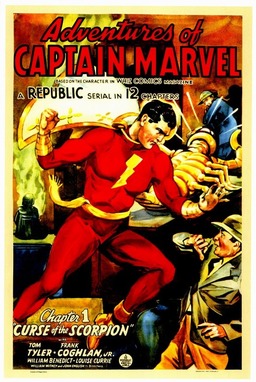 Pop quiz. Who was the first superhero to make it into film?
Pop quiz. Who was the first superhero to make it into film?
Yes — you in the back…what? Spawn?! Sit down! Okay… you there, in the Marvel Zombie tee-shirt… no, it was not Wolverine, though there may never be another superhero movie made without him. Yes, I see you… Superman? Good guess, but nope. Batman? Warmer, but still no.
The first superhero to make it into the movies was Captain Marvel (or as his four-color arch-nemesis, Dr. Thaddeus Bodog Sivana, contemptuously dubbed him, “That Big Red Cheese”), in the 1941 serial, The Adventures of Captain Marvel.
Captain Marvel and his alter ego, young radio reporter Billy Batson, made their first appearance in Fawcett’s Whiz Comics #2, in February of 1940. The character, the creation of writer Bill Parker and artist C.C. Beck, quickly became extremely popular, and for the remainder of the 1940’s, comics featuring him and the other members of the “Marvel Family” often outsold those featuring Superman.
National Periodical Publications (commonly known to comics fans as DC) tried to nip the rivalry in the bud by suing Captain Marvel out of existence in a legal wrangle that wouldn’t be decisively resolved until 1954. Well before that, though, Republic Pictures hopped on the bandwagon with The Adventures of Captain Marvel, a twelve-chapter serial that aficionados of the form regard as one of the best ever made.
The serial was directed by John English and William Whitney and written by the team of Ronald Davidson, Norman Hall, Arch Heath, Joseph Poland, and Sol Shor. They all keep the pot bubbling with action, peril, suspense, red herrings, and the crackling, popping energy that seems to be a unique feature of the best cliffhanger serials.
[Click on any of the images in this article for larger versions.]
Production vales are generally good, which means that the people in charge were imaginative and resourceful in making a movie on almost nothing, and that the cheapness endemic to these things doesn’t detract from the fun. (One of the pleasures of serial-watching is spotting costumes, props, sets, and even music that have been recycled from other movies.)
Chapter one, “Curse of the Scorpion,” begins with a title card that provides this vital information: “In a remote section of Siam, near the Burmese border, lies a desolate, volcanic land which has for centuries been taboo to white men — The Valley of Tombs!” Yes, it took five men to write that.
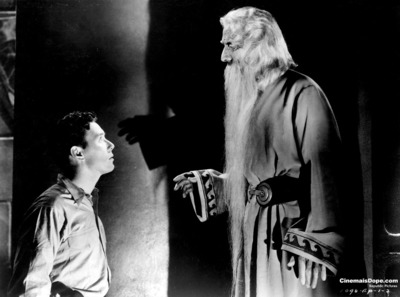 Visiting this “realm of mystery” is the Malcolm Archaeological Expedition. Their mission — to find the lost secret of the Scorpion Dynasty. They might have done better looking for it in Burbank, however, because as the episode opens, a gong is being sounded to summon hostile natives, touchy tribesmen who don’t want foreigners mucking about their holy places, especially the sacred tomb that the expedition proposes to open.
Visiting this “realm of mystery” is the Malcolm Archaeological Expedition. Their mission — to find the lost secret of the Scorpion Dynasty. They might have done better looking for it in Burbank, however, because as the episode opens, a gong is being sounded to summon hostile natives, touchy tribesmen who don’t want foreigners mucking about their holy places, especially the sacred tomb that the expedition proposes to open.
As turbaned horsemen gather in the hills, we enter the camp of the expedition and meet the interlopers: the avuncular leader, John Malcolm (Robert Strange) and his co-desecrators Professor Luther Bentley (Harry Worth), Henry Carlyle (Bryant Washburn), Doctor Stephen Lang (George Pembroke), James Howell (Jack Mulhall), and Professor Dwight Fischer (George Lynn). Also along for the ride are the obligatory female, Betty Wallace (Louise Currie), a porkpie-hatted hanger-on named Whitey (William Benedict), a slightly sinister, turban wearing Siamese advisor called Tal Chotali (John Davidson), and our hero in his original geek form, Billy Batson (Frank Coughlin Jr).
In true serial fashion, each character has one defining characteristic. Malcolm and the archaeologists’ function is to keep us guessing as to the identity of the villain; they are all suspects at one time or another, and so their job is to look suitably shifty, nervous, or guilty as the occasion demands — until they’re cleared by being killed, anyway.
Betty’s prime quality is helpless femaleness (surprise). She’s definitely not there for romantic interest, as she has all of the square sexlessness of a 1950’s sitcom mom. Whitey’s main distinction is bumbling haplessness, as very little goes right when he’s involved, which at least helps to keep the plot snarled. (If Walter White had seen this serial, he would certainly have chosen a different headgear for Heisenberg; Whitey would have ruined the porkpie for him.)
Tal Chotali provides syrup-voiced Oriental inscrutability (and another suspect) and Billy, as the surrogate for all of the ten year-old moviegoers shining each week’s seats, is suitably cheerful and optimistic. The original Billy Batson of the comics appeared to be about eleven years old, but here he’s in his early twenties, physically if not emotionally.
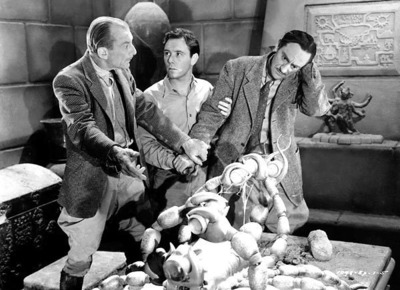 Upon hearing the distant gong, all of the expedition members gather to hear Tal Chotali’s explanation: “The men of the hills are gathering; the cymbal says that the white men are to be driven from the Valley of Tombs.” Always a quick thinker in a crisis, Malcolm orders that the stockade’s gate be closed… oh yes, and better man the machine guns. The tribesmen arrive and, under orders from their leader, Rahman Bar (Reed Hadley) fire a few shots into the camp.
Upon hearing the distant gong, all of the expedition members gather to hear Tal Chotali’s explanation: “The men of the hills are gathering; the cymbal says that the white men are to be driven from the Valley of Tombs.” Always a quick thinker in a crisis, Malcolm orders that the stockade’s gate be closed… oh yes, and better man the machine guns. The tribesmen arrive and, under orders from their leader, Rahman Bar (Reed Hadley) fire a few shots into the camp.
Tal Chotali goes out under a flag of truce to parley. Rahman tells him that “No white man shall desecrate the Valley of Tombs.” Tal Chotali tells him that there has been no such desecration, because the volcano Scorpio is quiet; “When there is desecration, Scorpio will erupt.” This ironclad logic balks Rahman Bar and the tribal leader pledges not to attack until the volcano belches.
Returning to camp, Tal Chotali tells the party that the natives will not attack if the foreigners agree to depart immediately. This prompts Malcolm’s deadpan reply, “But our visas and permits are in order!” This man is clearly not from around these parts. In any case, he decides to open the tomb at once and everyone marches over to the site. The expedition has apparently already been through the outer chambers, which look like a going out of business sale at Pier One Imports; only the inner chamber has yet to be breached. At this point, Billy and Tal Chotali refuse to go any farther. Billy wants no part of “prying into anyone’s secrets” (one wonders why he came along on an archaeological expedition) and Tal Chotali declares, “Billy Batson is the wisest one among us!” Admittedly the standard is not high.
Malcolm pries loose the remaining few blocks of stone that bar his way and, along with Bentley, Carlyle, Lang, Howell, and Fisher, enters the tomb, where they find, not any kind of sarcophagus, but a large golden model of a scorpion. Lenses (“probably a fused quartz of some kind”) are attached to its tail and legs, which turn out to be movable. In a spirit of scientific curiosity and Yankee meddling, the explorers line the lenses up and the result is an explosion that simultaneously knocks them out and seals them in.
Meanwhile, Billy has been dawdling in an outer chamber; the explosion causes a door to open and from it emerges an old, bearded man in a long white robe – the wizard Shazam (Nigel De Brulier), who explains that because Billy has refused to desecrate the tomb, he is now the guardian of the lensed scorpion; it will be his duty to see to it that “the Golden Scorpion doesn’t fall into the hands of selfish men.” Billy’s priceless reply should be dear to the hearts of slackers everywhere. “My duty?” he bleats.
Yes, his duty, but he will of course have some help. By repeating the wizard’s name, Billy will become Captain Marvel and will possess the wisdom of Solomon, the strength of Hercules, the stamina of Atlas, the power of Zeus, the courage of Achilles, and the speed of Mercury. (It will come up in a crossword puzzle sometime; trust me.) All in all, it’s a pretty good deal, and, repeating the mystic name, Billy vanishes in a flash of lightning and a cloud of smoke, and Captain Marvel appears. Wimpy Frank Coughlin Jr. has been magically replaced by beefy Tom Tyler, a B-movie western actor best known for getting plugged by John Wayne at the end of Stagecoach.
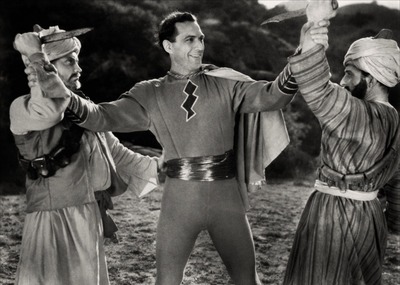 After a quick grin of pleasure at the improvements evident in his new incarnation, Captain Marvel pulls away the enormous stone that has sealed the archaeologists in the inner tomb… and then speaks Shazam’s name, changing back into Billy. Why? Don’t ask. Billy helps revive the men and they carry the Golden Scorpion outside, where Tal Chotali reads from a scroll which says that the Scorpion’s lenses can change base substances into gold. This is quickly tried on a few rocks and, lo and behold, it works!
After a quick grin of pleasure at the improvements evident in his new incarnation, Captain Marvel pulls away the enormous stone that has sealed the archaeologists in the inner tomb… and then speaks Shazam’s name, changing back into Billy. Why? Don’t ask. Billy helps revive the men and they carry the Golden Scorpion outside, where Tal Chotali reads from a scroll which says that the Scorpion’s lenses can change base substances into gold. This is quickly tried on a few rocks and, lo and behold, it works!
This is of course a power too great to be trusted to any one man, so it’s decided that the lenses will be taken off and divided among the expedition’s main members, while Billy will be entrusted with the scroll. Malcolm decrees that they will break camp and head out in the morning. Certainly nothing can stop them; their visas and permits are in order…
That night, as the occidentals snooze in their tents, a mysterious figure stalks through the camp. Wearing a long dark robe and with his features completely concealed by a hood, this can be none other than the villain of the piece — the Scorpion himself! (Any doubt is removed by the large scorpions emblazoned on his outfit, which certainly looks very comfortable, just the thing for lounging around a secret lair at the the end of a long day of perfidy.) The Scorpion lights a signal fire in the middle of the camp and retires into the shadows between the tents. Rahman Bar sees the signal and assembles his men outside the stockade. But how to get in? Since he didn’t just open the gate, apparently the Scorpion wants them to learn the value of figuring things out on their own; after all, how will they ever grow up to be supervillains themselves if everything is done for them?
Now comes one of those moments of innovative absurdity so highly prized by serial-lovers. The tribesmen pull back the top of a small tree – not much more than a sapling — and hold it back as one of their compatriots climbs onto it and lays back. The natives then let go, and woosh! The daring assassin flies through the air and tumbles expertly to the ground, inside the fence, just like one of the Flying Wallendas. Really. Two more follow by the same method and, slipping into Billy’s tent, they conk the kid on the head, then tie and gag him; he’s going to get gagged a lot in the course of twelve chapters — you can probably figure out why.
The Scorpion now enters and directs his henchmen to take the scroll and the lensless Golden Scorpion. (By the way, you can’t guess who the Scorpion is from his voice — his dialogue is all spoken by Gerald Mohr, who doesn’t actually appear in the serial. Is this cheating? You bet it is!) The natives obey and, in making their escape, are discovered by Howell. They quickly dispatch him with a knife; he can rest easy, knowing that no one will ever suspect him of being the Scorpion.
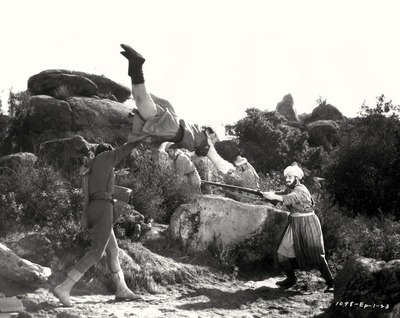 Billy comes to and, still bound and gagged, hops over to Malcolm’s tent. His thrashing around outside attracts Malcolm’s attention and the expedition leader emerges, takes one look at Billy, and says…”Why Billy – what’s up?” Once the gag is out, Billy tells him and they quickly radio the British garrison at Fort Mooltan for help. The troops are on the march instantly (literally) and while the beleagured explorers wait for their arrival, Bently sneers, “I don’t think there’s a native within ten miles of here.” Perhaps he thinks Howell’s knife wounds are psychosomatic.
Billy comes to and, still bound and gagged, hops over to Malcolm’s tent. His thrashing around outside attracts Malcolm’s attention and the expedition leader emerges, takes one look at Billy, and says…”Why Billy – what’s up?” Once the gag is out, Billy tells him and they quickly radio the British garrison at Fort Mooltan for help. The troops are on the march instantly (literally) and while the beleagured explorers wait for their arrival, Bently sneers, “I don’t think there’s a native within ten miles of here.” Perhaps he thinks Howell’s knife wounds are psychosomatic.
The words are no sooner out of his mouth than the camp is bracketed by flaming spears and machine gun bullets. Rahman Bar’s conscience is clear – Scorpio is now is full eruption. The British troops arrive (Fort Mooltan must have been half a mile away) but are pinned down by the natives. In an attempt to link up with the troops “across the gorge,” everyone piles into two station wagons and drives out of camp, not knowing that Rhaman Bar has sent men to dynamite the bridge. Only Billy remains behind, and safely alone, and he speaks the magic name. Captain Marvel appears and flies over the fence to chastise the obstreperous tribesmen.
This is the best place to talk about the flying effects in The Adventures of Captain Marvel. They are really wonderfully well done. For some shots, a life size dummy was constructed and flown along well-concealed wires; some shots are of Tom Tyler in a flying harness, in front of a cloud-filled process screen; other shots are of stuntman Davy Sharpe making extraordinary leaps onto or off of the ground, buildings, cliffs, vehicles, etc. These effects remain one of the best reasons to see the serial, even after so many years and so many advances in special effects.
Landing in a machine gun nest, Captain Marvel effortlessly tosses one native away, and the other three sensibly flee; determined not to waste such a rare opportunity, Captain Marvel machine guns them in the back.
No, you didn’t misread that. He shoots them in the back; doubtless The Adventures of Captain Marvel is Frank Miller’s favorite serial. Our hero flies over to another group and takes two out with a kicking backflip that is truly something to see. Along the way, Captain Marvel gets shot several times and is pleased to discover that it doesn’t bother him a bit.
As all this is going on, the first station wagon gets across the bridge safely. As the second vehicle, containing only Whitey and Betty, starts across, the dynamite goes off in front of them. The weakened structure starts to collapse, and as Whitey vainly struggles to find reverse, the whole bridge gives way. (See what I meant about Whitey?) The last thing we see is the station wagon tumbling into the gorge.
Whew! What a workout! Thankfully, the remaining episodes are only half the length of the opener’s thirty minutes.
Are Whitey and Betty doomed? Will Malcolm and his colleagues get the lenses back to the states? Does Tal Chotali have any hair under that turban? Will Captain Marvel become a spokesman for the NRA? The answers to (some of) these and other questions will be found in next week’s exciting chapter, “The Guillotine.”
See you then!
Thomas Parker is a native Southern Californian and a lifelong science fiction, fantasy, and mystery fan. When not corrupting the next generation as a fourth grade teacher, he collects Roger Corman movies, Silver Age comic books, Ace doubles, and despairing looks from his wife.
I believe everyone considers Batman a superhero, yet he has no superhero powers. Given this, I believe it was The Shadow who made it to film first as a superhero (at least he has “the ability to cloud men’s minds”) as well as his detective skills.
The first The Shadow film was in 1937, several years before the Captain Marvel film. Here’s the wikipedia link:
http://en.wikipedia.org/wiki/The_Shadow_Strikes
I don’t wish to detract from the obvious love for and appeal of Captain Marvel in any way. I just don’t believe he was the first superhero to make it to film. Otherwise a fun, informative article and thanks for writing it.
DTruesdale, your point is legitimate; The Shadow was in a couple of poverty row productions as far back as 1937. But do most people today (those who are even aware of the character, that is) consider him a “superhero” in the same sense as Superman, Captain Marvel, or even Batman? I myself don’t, even though the Shadow certainly has much in common with them, especially Batman, as you point out. (Secret identity, special gadgets and vehicles, unique garb – even if it is largely off the rack – secret lair, etc.) I think the Shadow is more of a “pre” or “proto” superhero rather than a full-flown “out of the chrysalis” example as the other three – even Batman – are. What’s the difference? For me, it’s largely a matter of mood and emphasis, and the feel of the universe they inhabit. By those criteria, I think the Spider (who also made it into the movies via his own serial in 1938, two years before Captain Marvel) is closer to a superhero, in that he regularly faced more extreme, outlandish menaces than those usually dealt with by the Shadow. But for me, anyway, both Shadow and Spider fall into the category of important influences/significant precursors rather than being actual superheros as we now define tham. Your milegae may vary, of course!
Hi, Thomas,
I appreciate your thinking on this issue but don’t think your attribution of the Shadow as a “pre” or “proto” superhero–but not now a real superhero–hold up well.
Using your criteria, consider this analogy: H. G. Wells was writing science fiction long before it acquired that genre name. Does it make what he wrote any less science fiction?
I think the same applies to the Shadow; just because the term superhero is now commonly used to accept characters like Batman (and even Green Arrow, who also fails to have super powers) as superheroes, it must also include early characters like the Shadow.
Besides, the popularity of superheroes waxes and wanes over time, it comes and goes–but once a superhero always a superhero, regardless of the popularity of that superhero. And remember too that the Shadow is still very popular today for yet another generation of readers. He’s had a radio show, a magazine, several movies, comic books, and Anthony Tollin has been for some years now reprinting all of the Shadow’s magazine adventures in marvelous and collectible formats.
The Shadow! One of the earliest of all superheroes who, along with Doc Savage, begat Batman in the first place (Batman combining qualities of both Savage and the Shadow).
But this is all in good fun. Please define “superhero” in any way you so desire and above all have fun with it. Having fun is the most important thing above all else when discussing superheroes (say I, a big fan of THE BIG BANG THEORY). 🙂
Take care, Thomas.
–Dave
Dave, I meant no disrespect to the Shadow – he’s certainly one of the most interesting and durable of all pop heroes, and for good reason. And you’re right – disputes like ours always boil down to a matter of definitions. (It does seem to me that yours would admit a lot of characters that lie outside the reasonable boundaries of “superherodom” – Tarzan, Conan, Fu Manchu?) You think I cast the net too narrowly, and I think you cast it too widely, but as you say, the point is to enjoy these great creations, and we’re obviously both on the right side of the fence in that regard. Thanks for your thoughtful reading and comments!
Why exclude Tarzan? He can talk with the jungle fauna.
Moreover, Tarzan had bizarre adventures.
http://www.blackgate.com/2014/01/31/spotlight-on-fantasy-webcomics-do-superheroes-qualify-as-fantasy/feed/
For The Encyclopedia of Superheroes by Jeff Rovin (1985), Rovin did provide entries for Conan and Tarzan*. For their entries, he notes in passing other jungle adventurers in prose and film as well as sword and sorcery properties He also provided an entry for Zorro, despite most of, if not all, of McCulley’s Zorro tales lacking the paranormal. In 1994′s Adventure Heroes, Rovin noted these as borderline properties.
Rowling’s Harry Potter debuted in 1996, so how Rovin would have handled him stands as unclear.
*
http://monsterkidclassichorrorforum.yuku.com/topic/47406/loves-ya-baby-Universal-loves-rebooting-Kojak-movie scroll down for Tarzan digression
As we see, the tent is getting very big indeed; once it exceeds a certain size, categories tend to become meaningless. I remember Bill Blackbeard, in an essay in All In Color For a Dime, made a case for Popeye as being the first superhero. I don’t agree with him (and I’m not even sure he was entirely serious), but what the heck – one man’s Shazam is another man’s spinach. Whatever your taste, enjoy!
And as long as we’re on this tack, I’ll trump you all and cite Odysseus as the first superhero. So there! (All you Gilgamesh fans, write your own article!)
[…] Republic Pictures’ 1941 serial, The Adventures of Captain Marvel. We opened last week with Curse of the Scorpion. Today, Chapter Two: “The […]
What often happens with the pre-Superman properties such as the Lone Ranger, attempts to revive them rarely produce a sequel, though people do sometimes refer to them as part of the genre. Tarzan fits the pattern after 1968 or so.